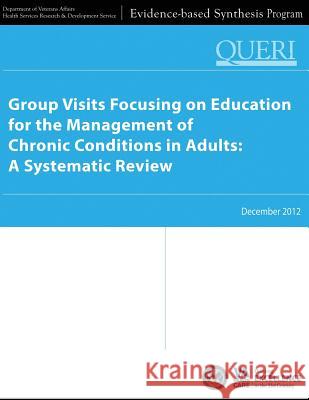Group Visits Focusing on Education for the Management of Chronic Conditions in Adults: A Systematic Review » książka
Group Visits Focusing on Education for the Management of Chronic Conditions in Adults: A Systematic Review
ISBN-13: 9781495924439 / Angielski / Miękka / 2014 / 120 str.
Group Visits Focusing on Education for the Management of Chronic Conditions in Adults: A Systematic Review
ISBN-13: 9781495924439 / Angielski / Miękka / 2014 / 120 str.
(netto: 75,98 VAT: 5%)
Najniższa cena z 30 dni: 79,56
ok. 16-18 dni roboczych
Dostawa w 2026 r.
Darmowa dostawa!
The goal of group-based educational programs led by non-prescribing facilitators is to communicate information and provide training in order to improve self-management skills for the large numbers of patients coping with chronic illness. The Veterans Administration (VA) has prioritized group visit implementation as part a new primary care model that focuses on patient centeredness, The Patient Aligned Care Team (PACT), but the choice of which patient populations to target and which interventions to use is unclear. Though the group visit intervention delivery model has been widely used, there are vast differences in program structure, content, length of intervention, and follow-up time points. Moreover, there is little consensus as to whether, and for whom, group visits are an effective tool. Given the variety of interventions, the broad array of chronic conditions in which group visit interventions have been studied, and the lack of an overall understanding of effectiveness, it is useful to clarify what is known and not known about group visit interventions in patients with chronic illness. To our knowledge, no recent review has examined group visit interventions across a variety of conditions. The objectives of this review are to: 1) summarize the characteristics of group visit interventions that have been tested in controlled trials of patients with chronic illness; 2) assess the effects of these interventions on quality of life, self-efficacy, health care utilization, and other health outcomes; 3) understand whether there are certain patient characteristics associated with intervention effectiveness; and 4) examine which components of group visit intervention structure and delivery may be associated with intervention effects. We address three key questions in our review of the literature on group visits conducted by non-prescribing health professionals and lay facilitators: Key Question 1. In adults with chronic medical conditions, how do group visits compared to usual care affect the following: (1) medication adherence, biophysical markers ( e.g., HbA1c, blood pressure) (2) symptom status, functional status, mortality, patient satisfaction (3) utilization of medical resources, health care costs (4) adverse outcomes (e.g., patient confidentiality, participation/missed appointments)? Key Question 2. For adults with chronic medical conditions, do the effects of group visits vary by patient characteristics? Characteristics of interest include medical diagnosis, severity of disease, and comorbidities. Key Question 3. (Depending on the size and comparability of elements identified in the literature) Which components of group visits are associated with greater intervention effects?
Zawartość książki może nie spełniać oczekiwań – reklamacje nie obejmują treści, która mogła nie być redakcyjnie ani merytorycznie opracowana.











